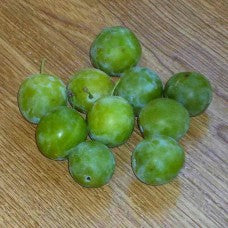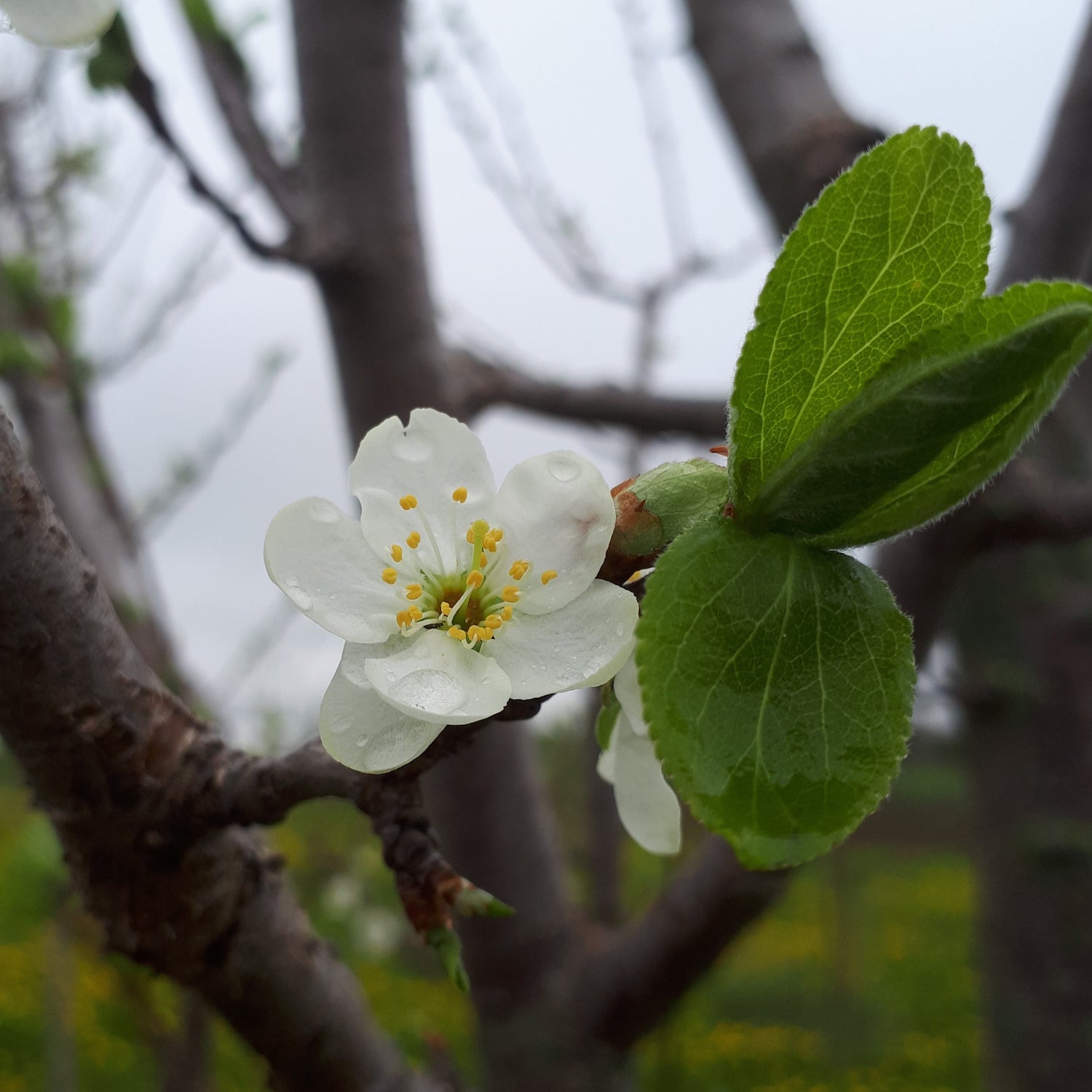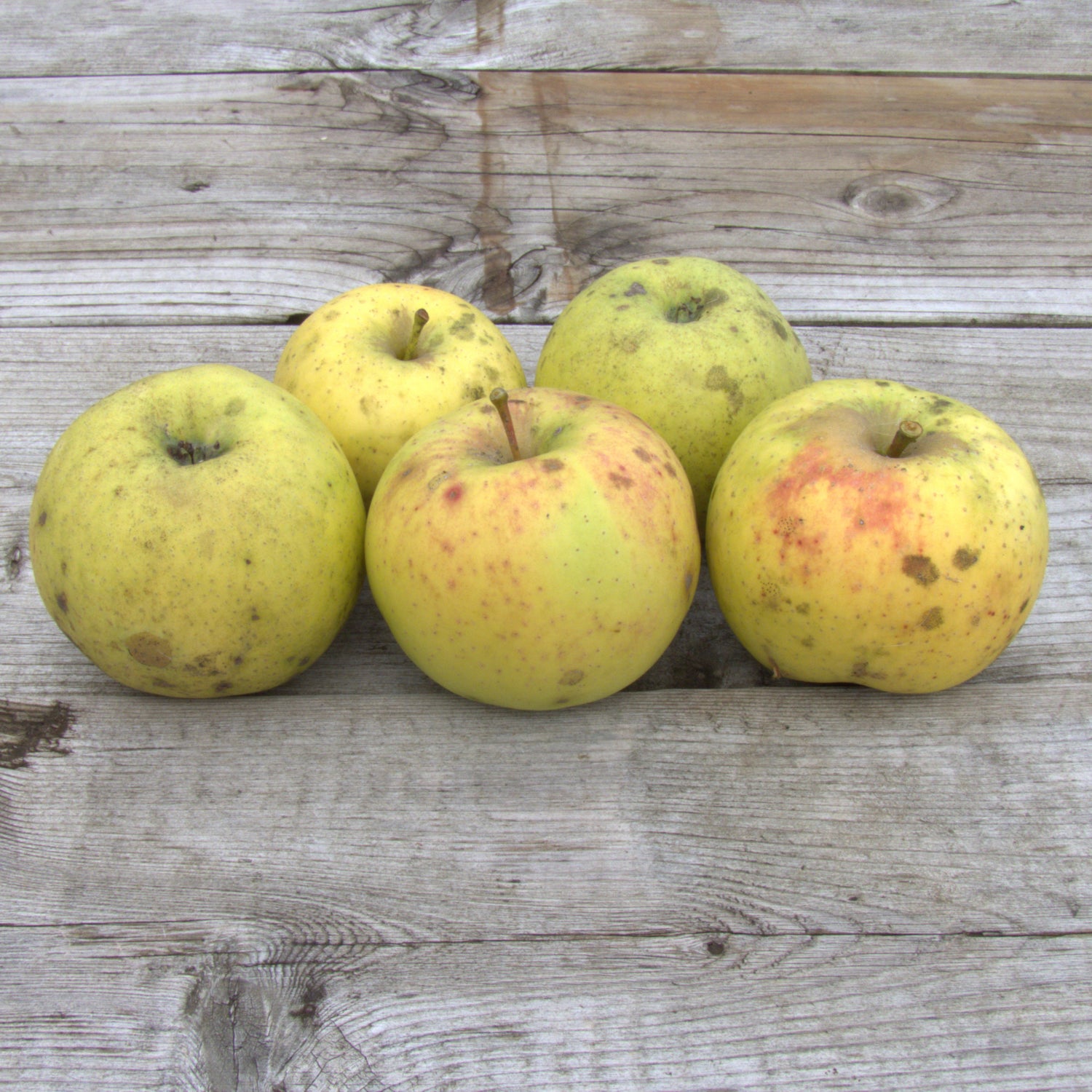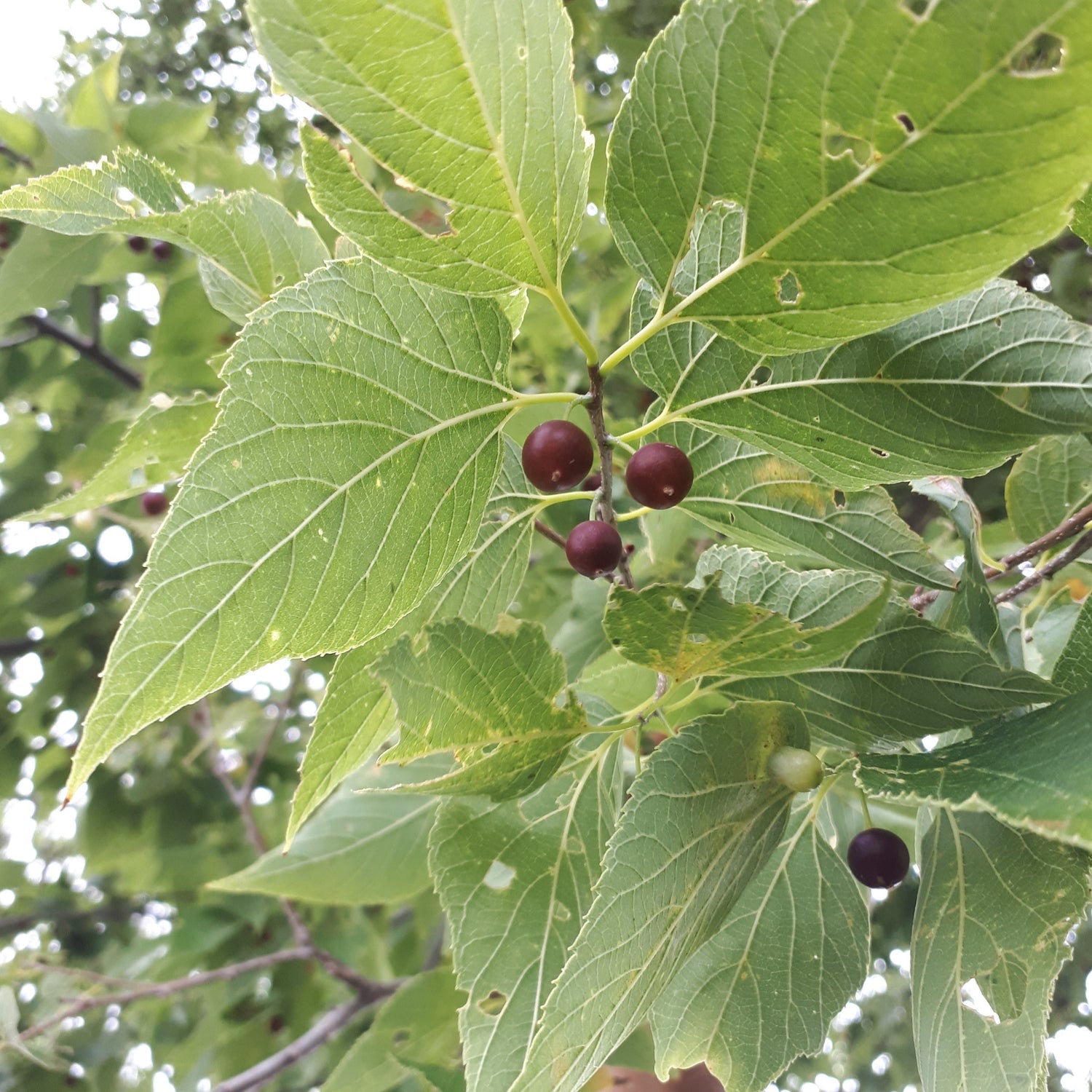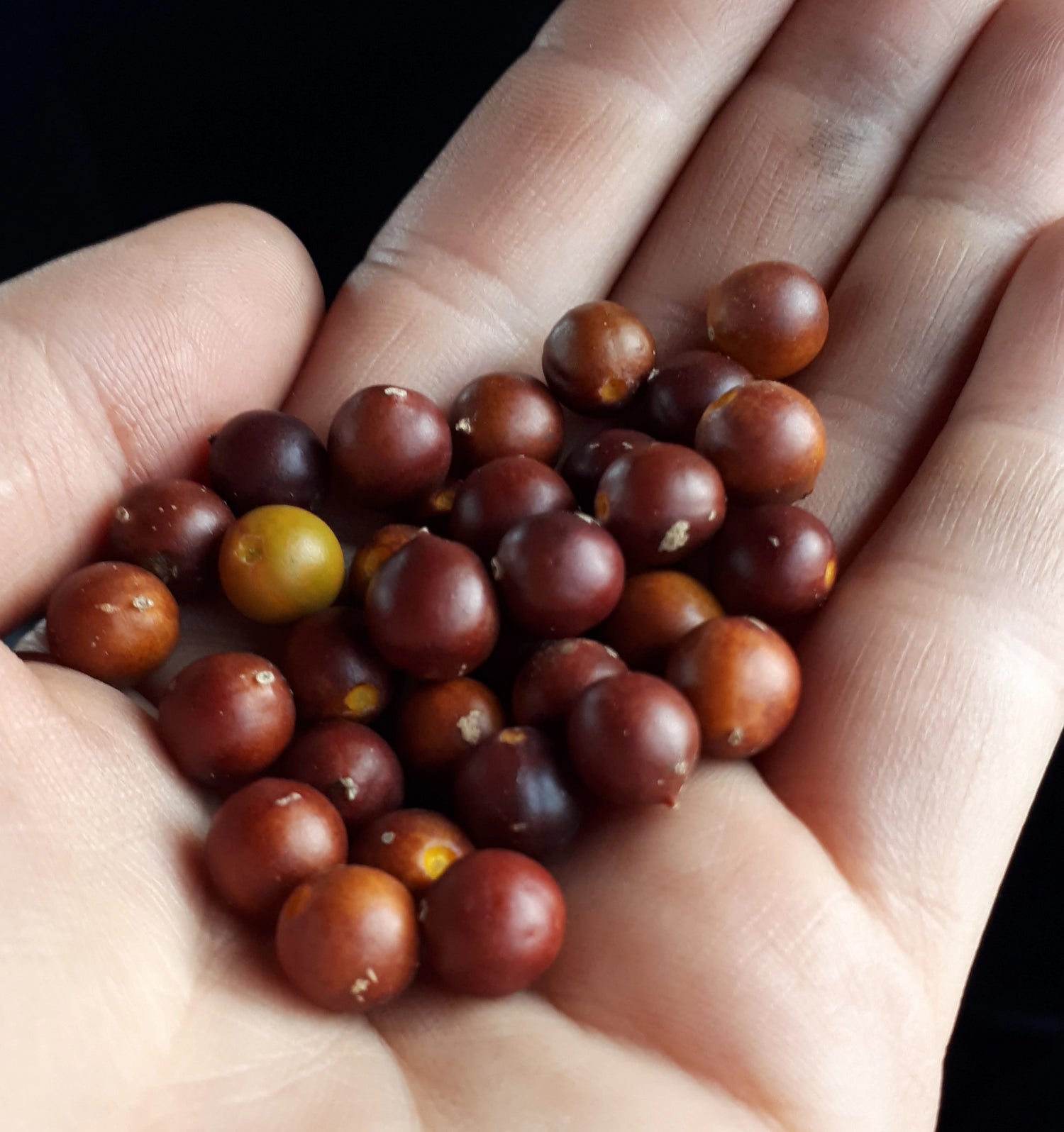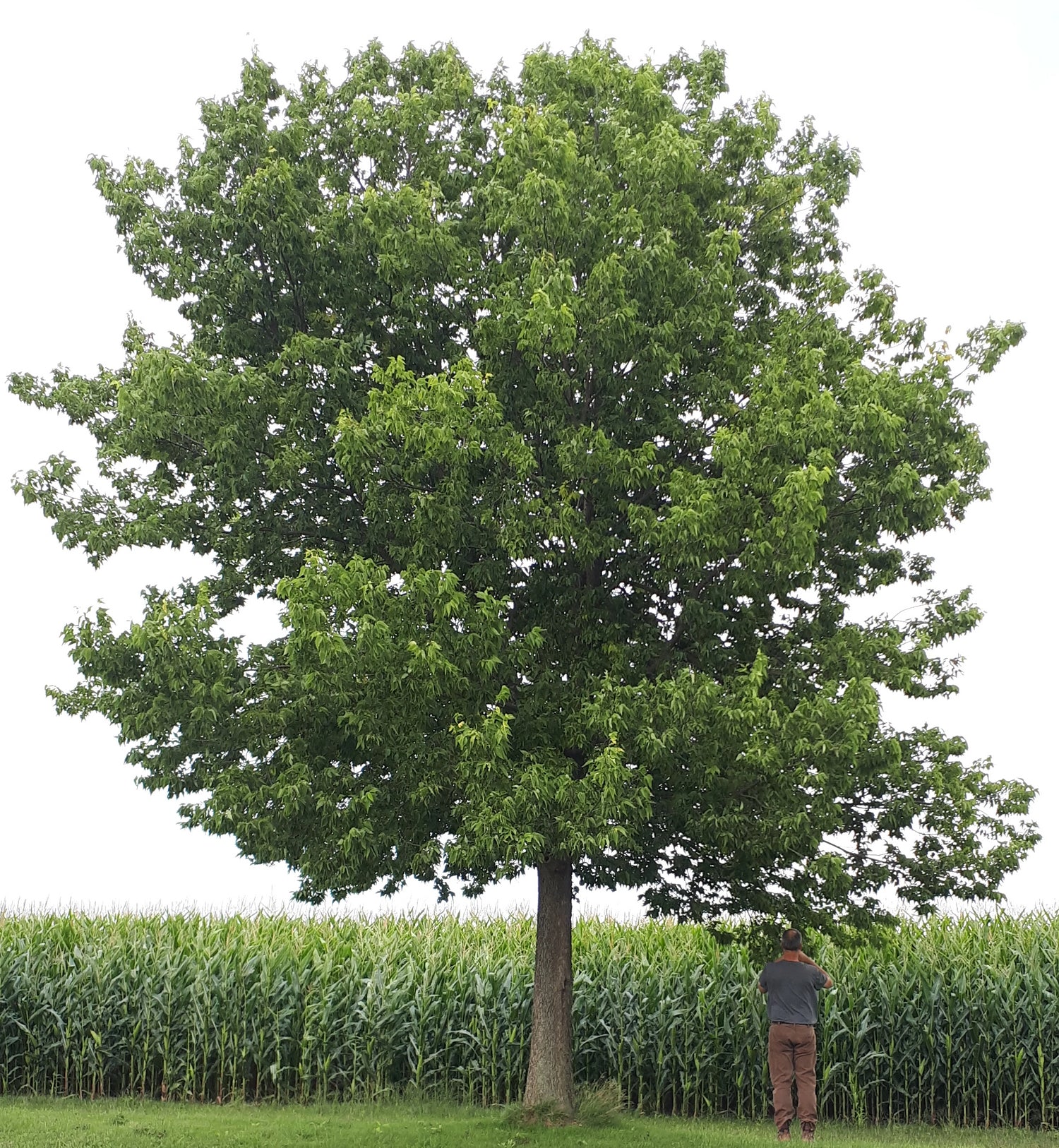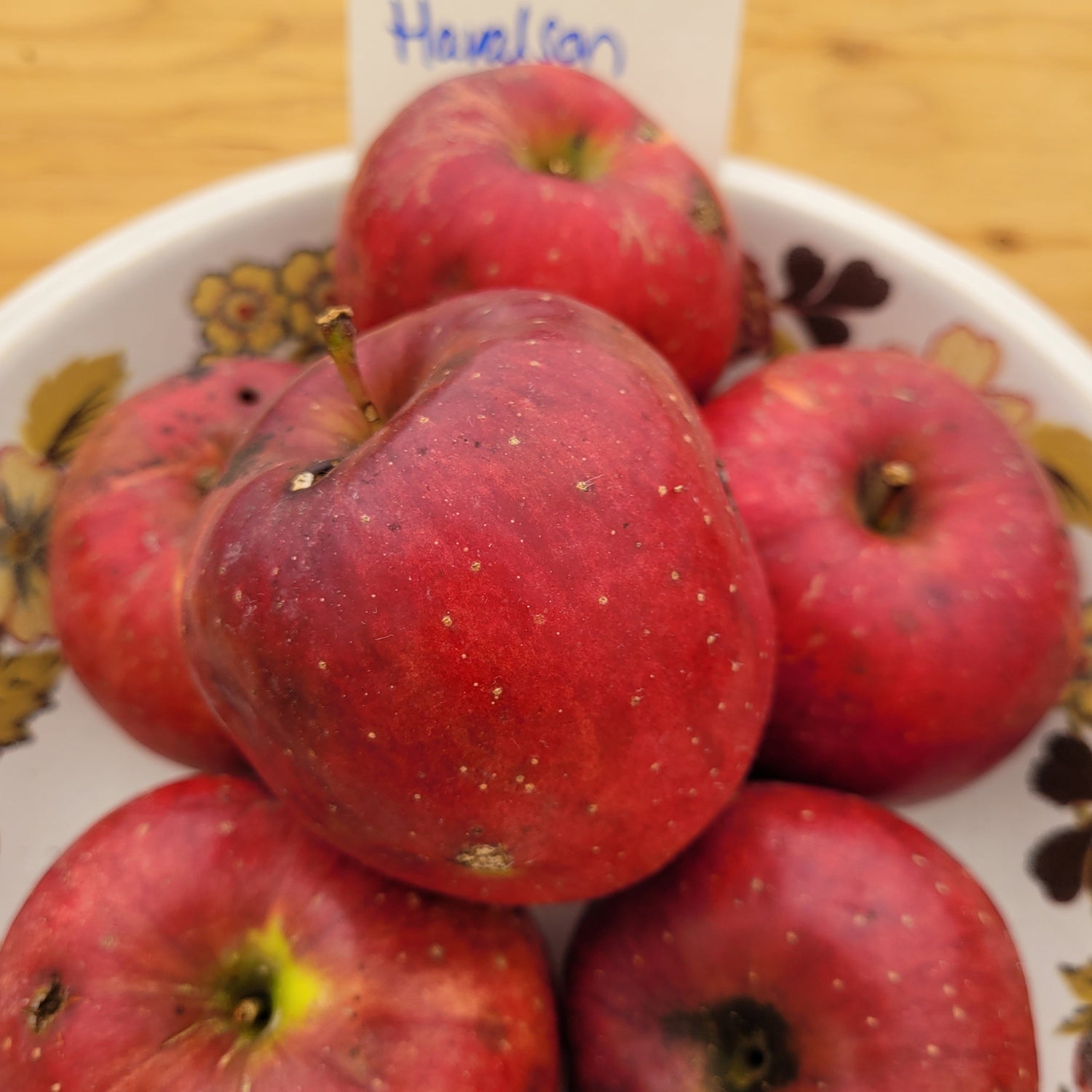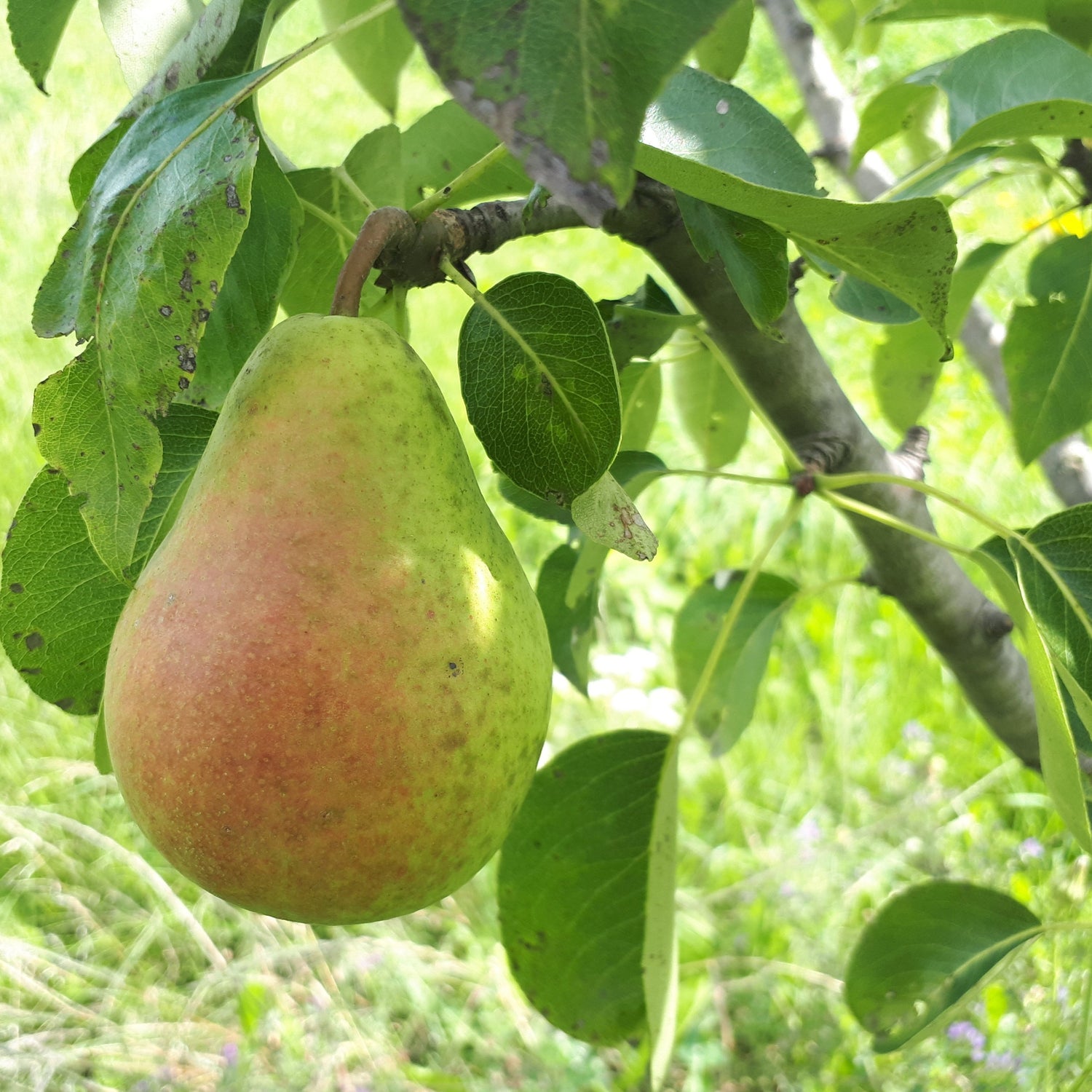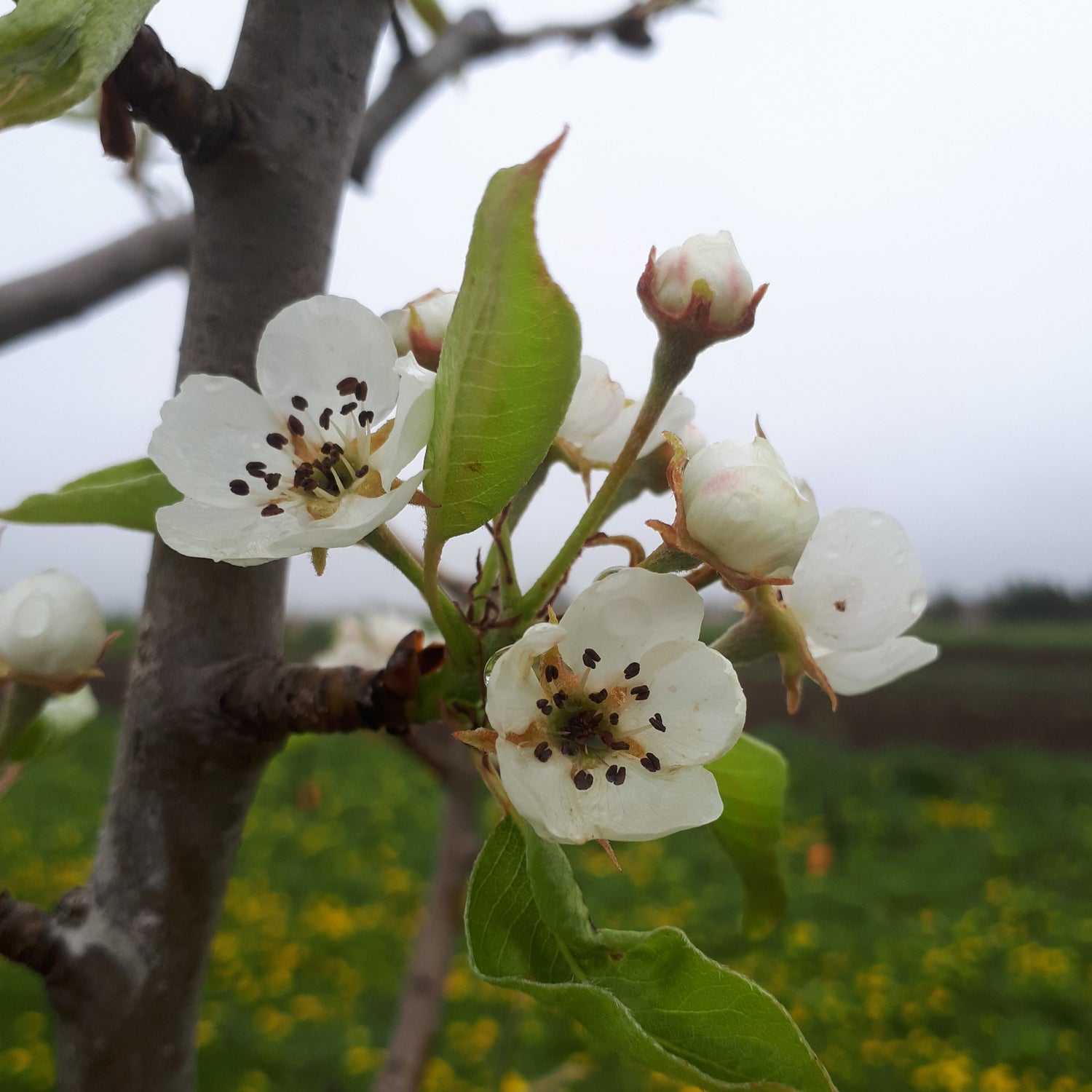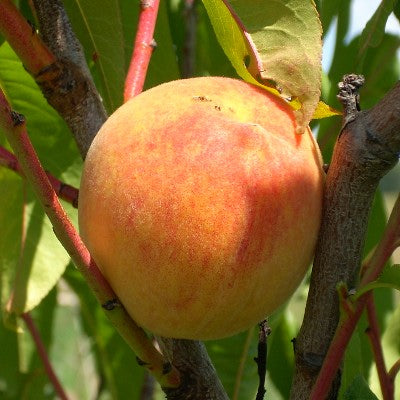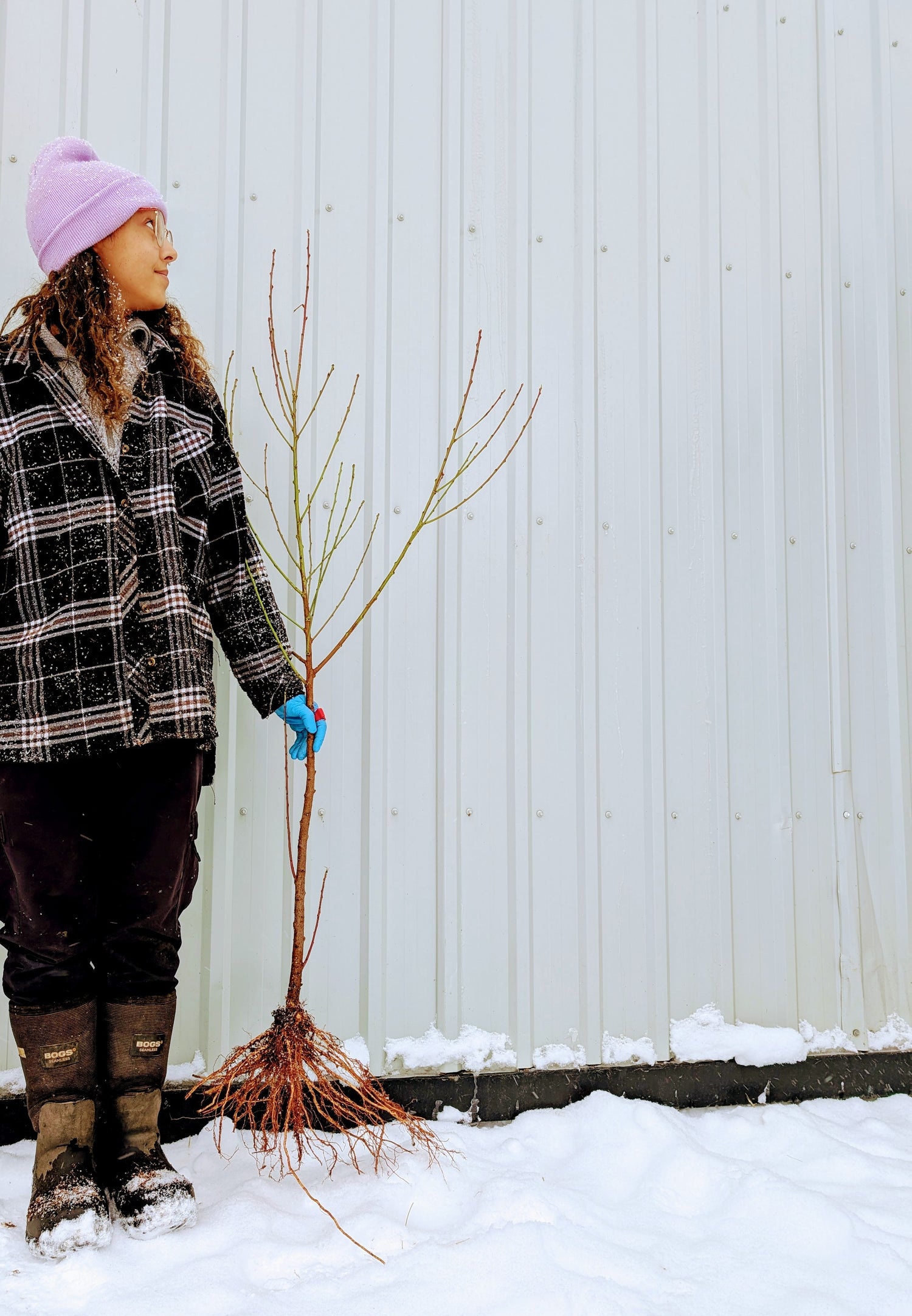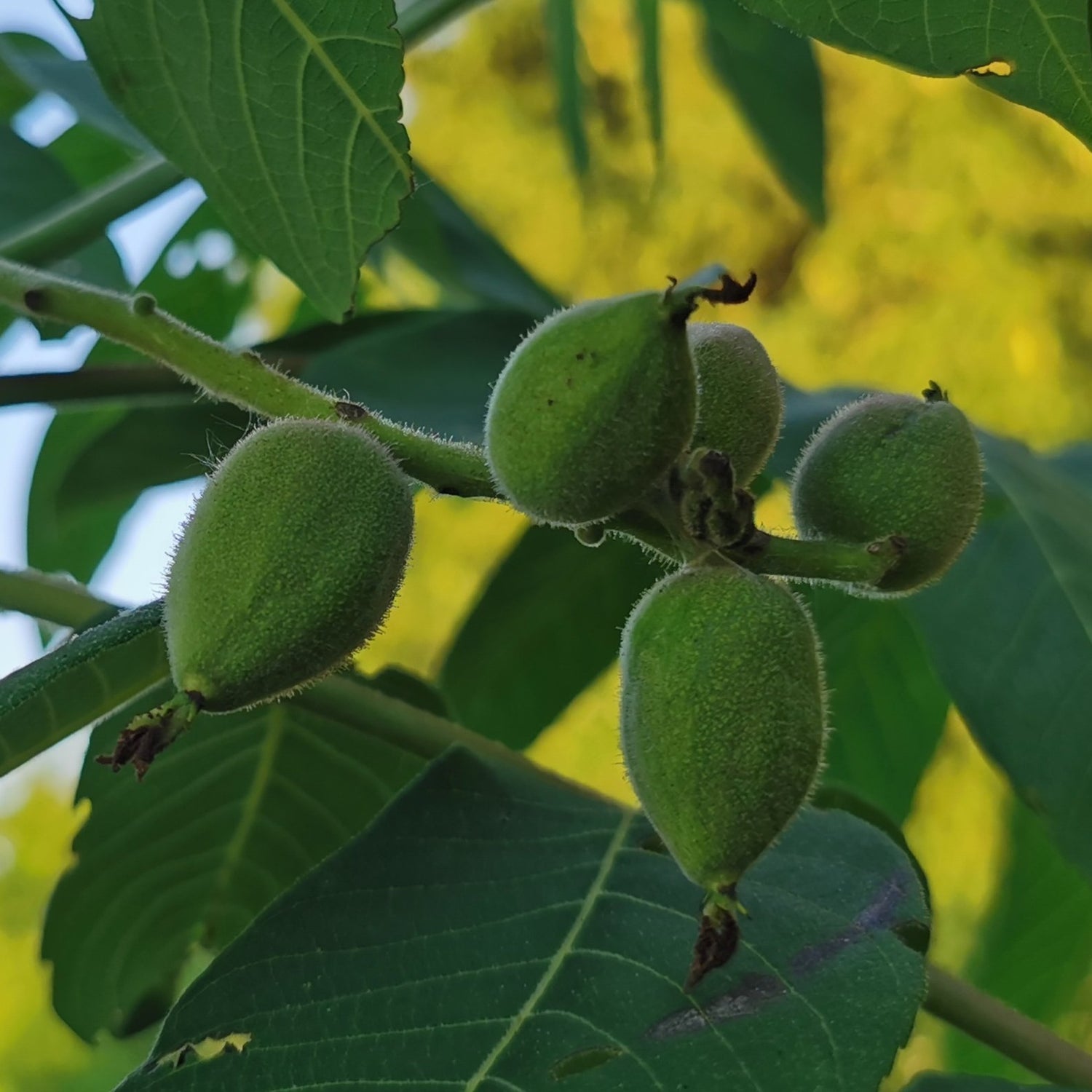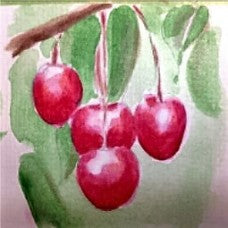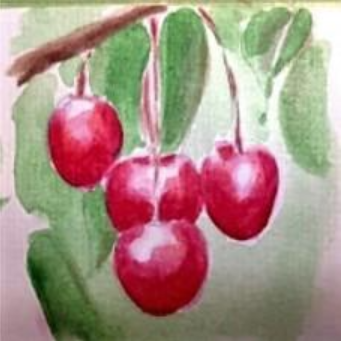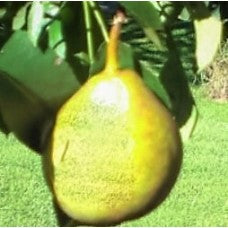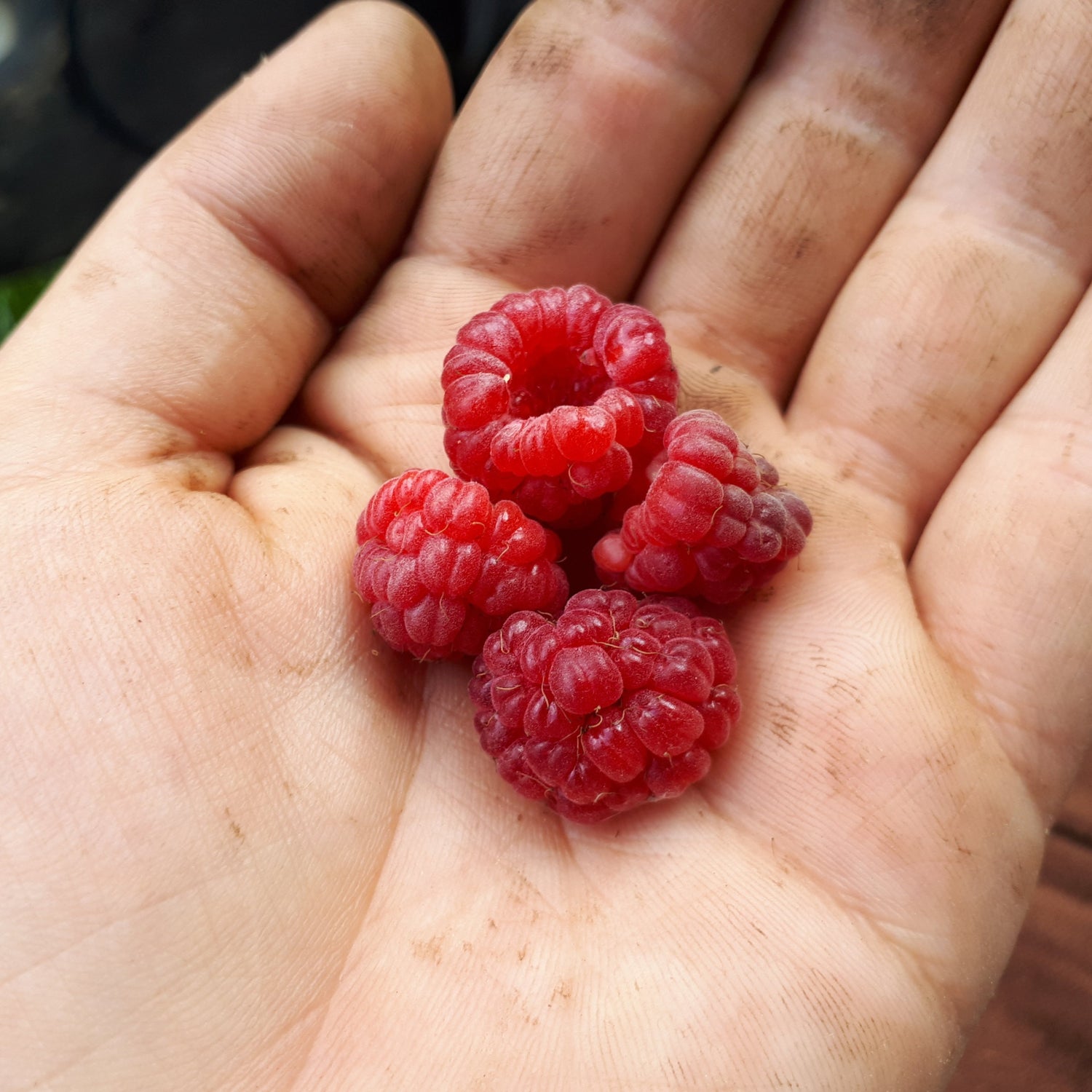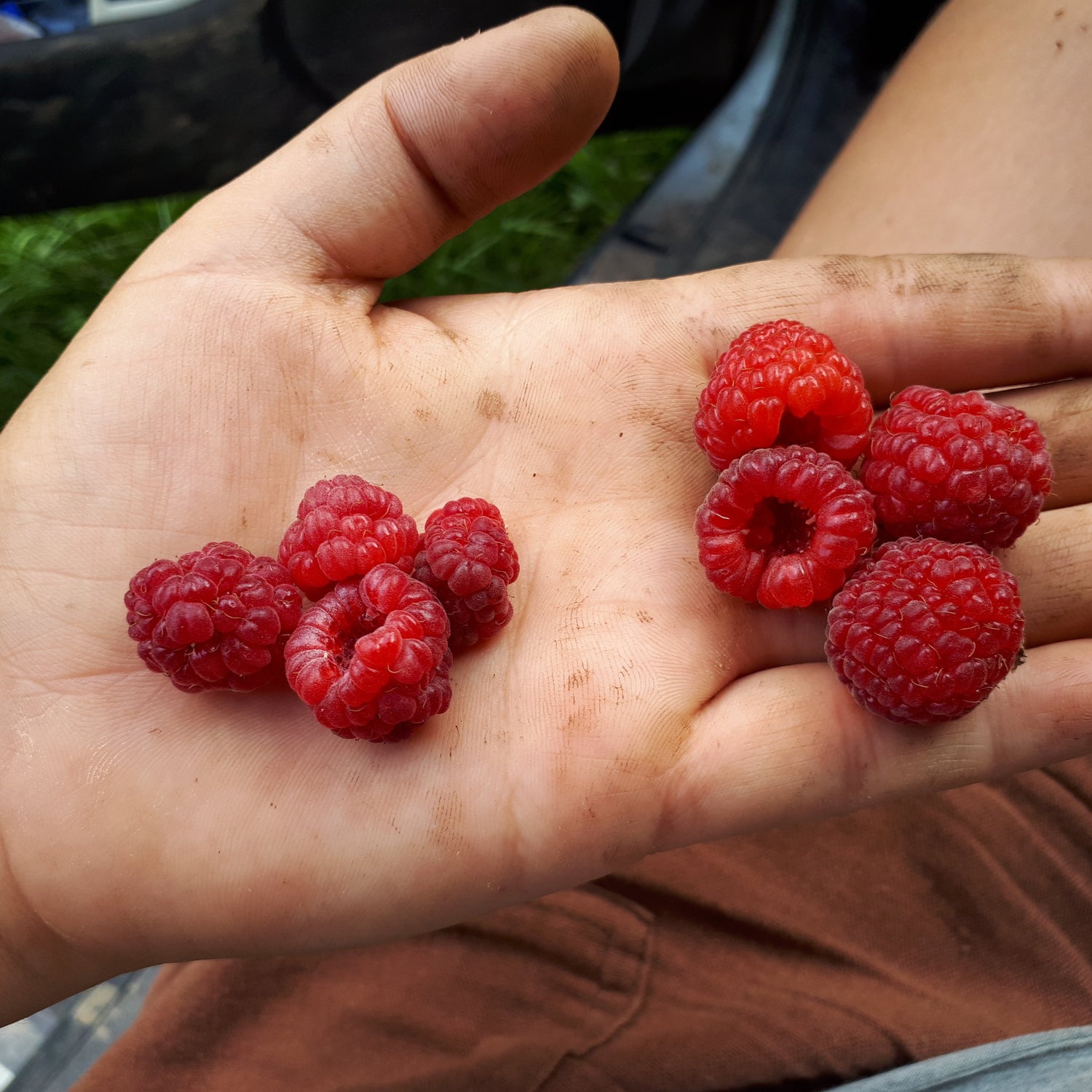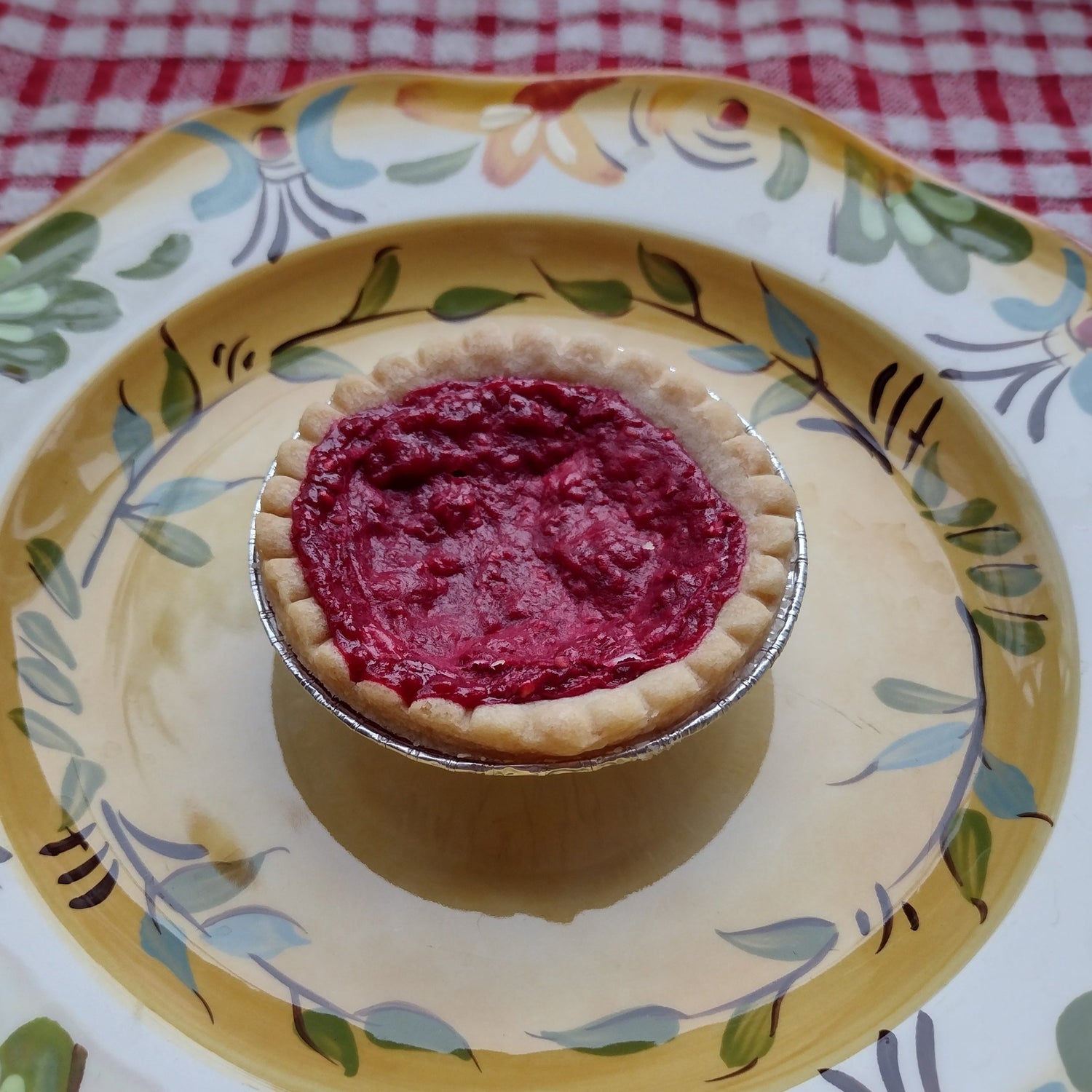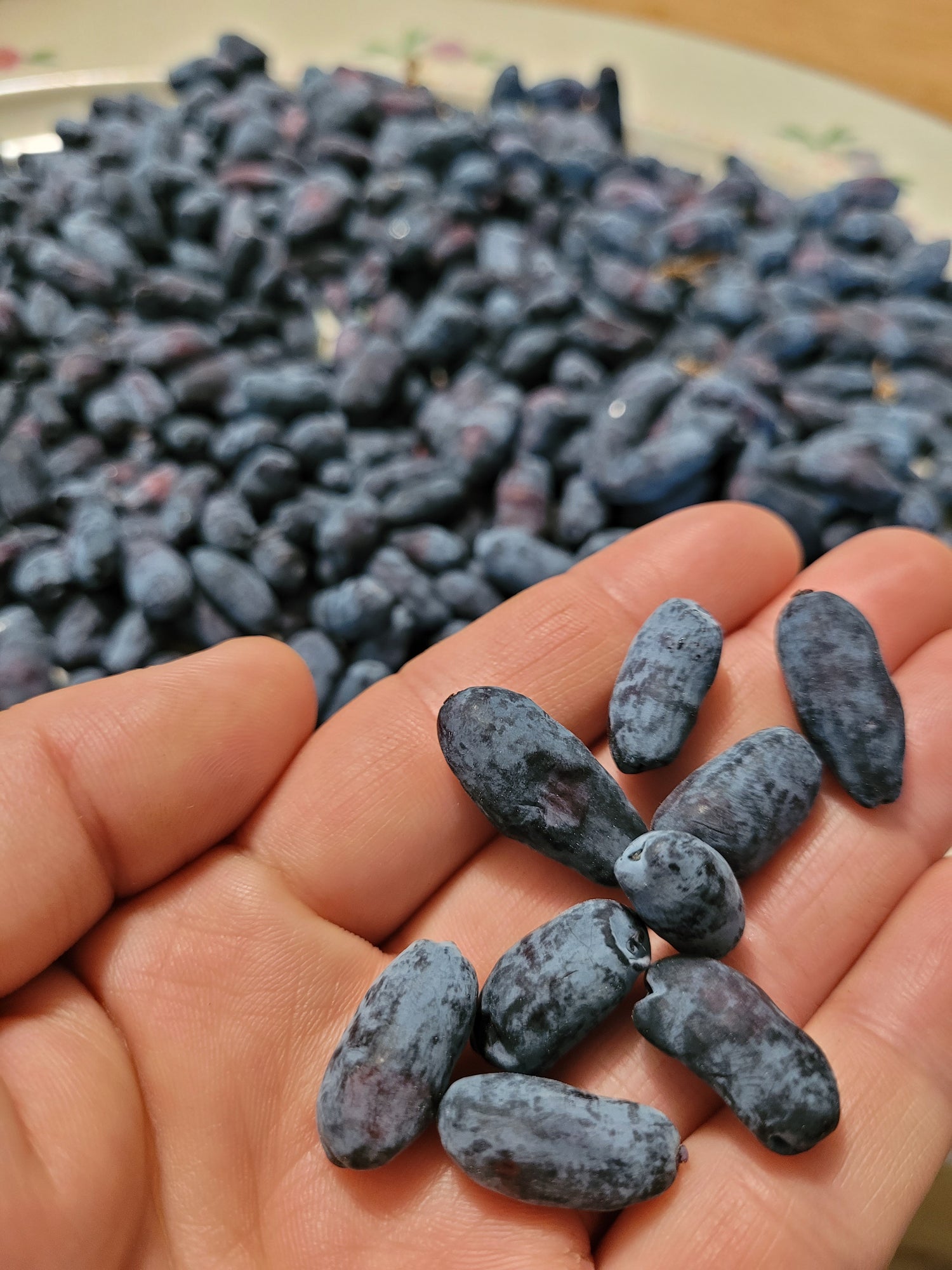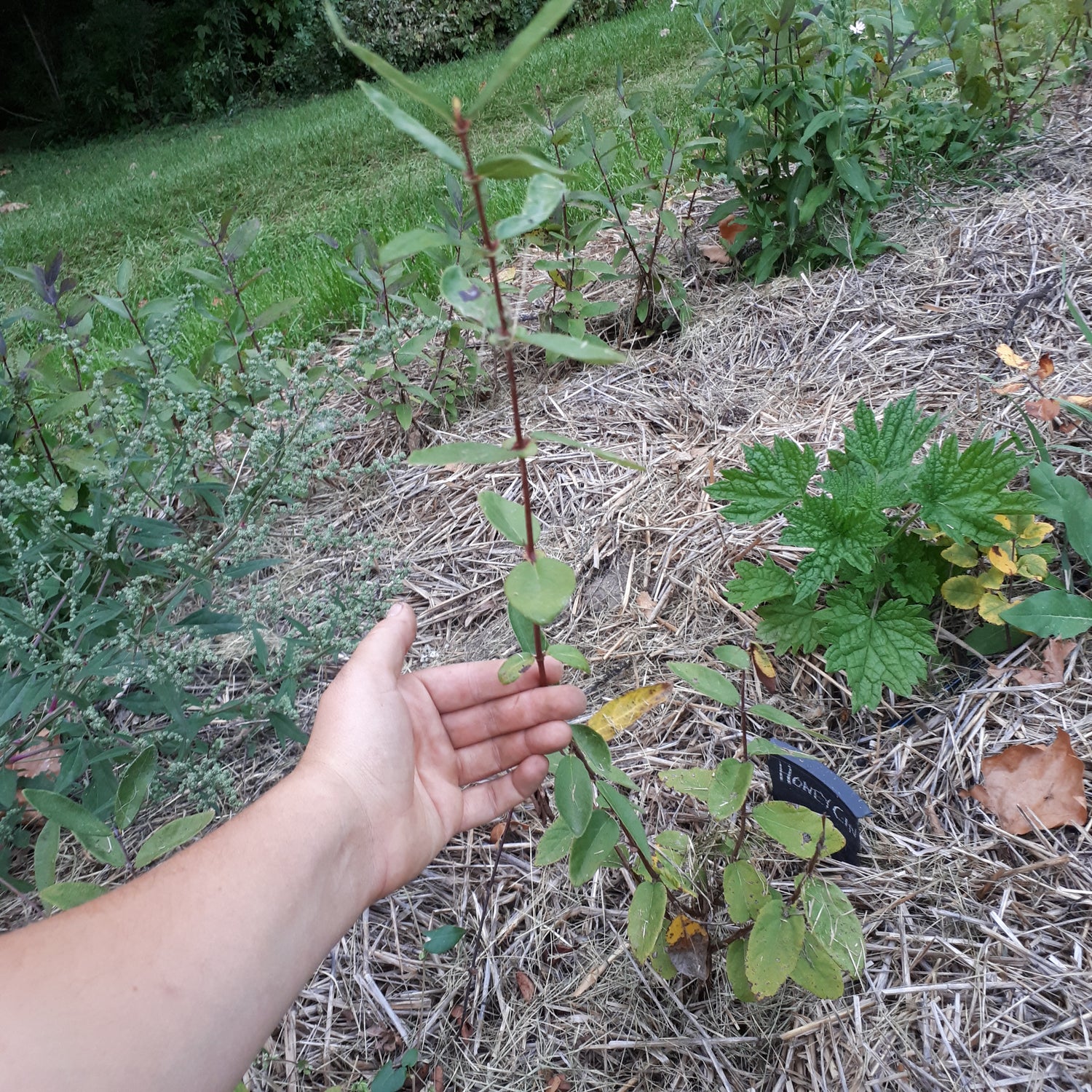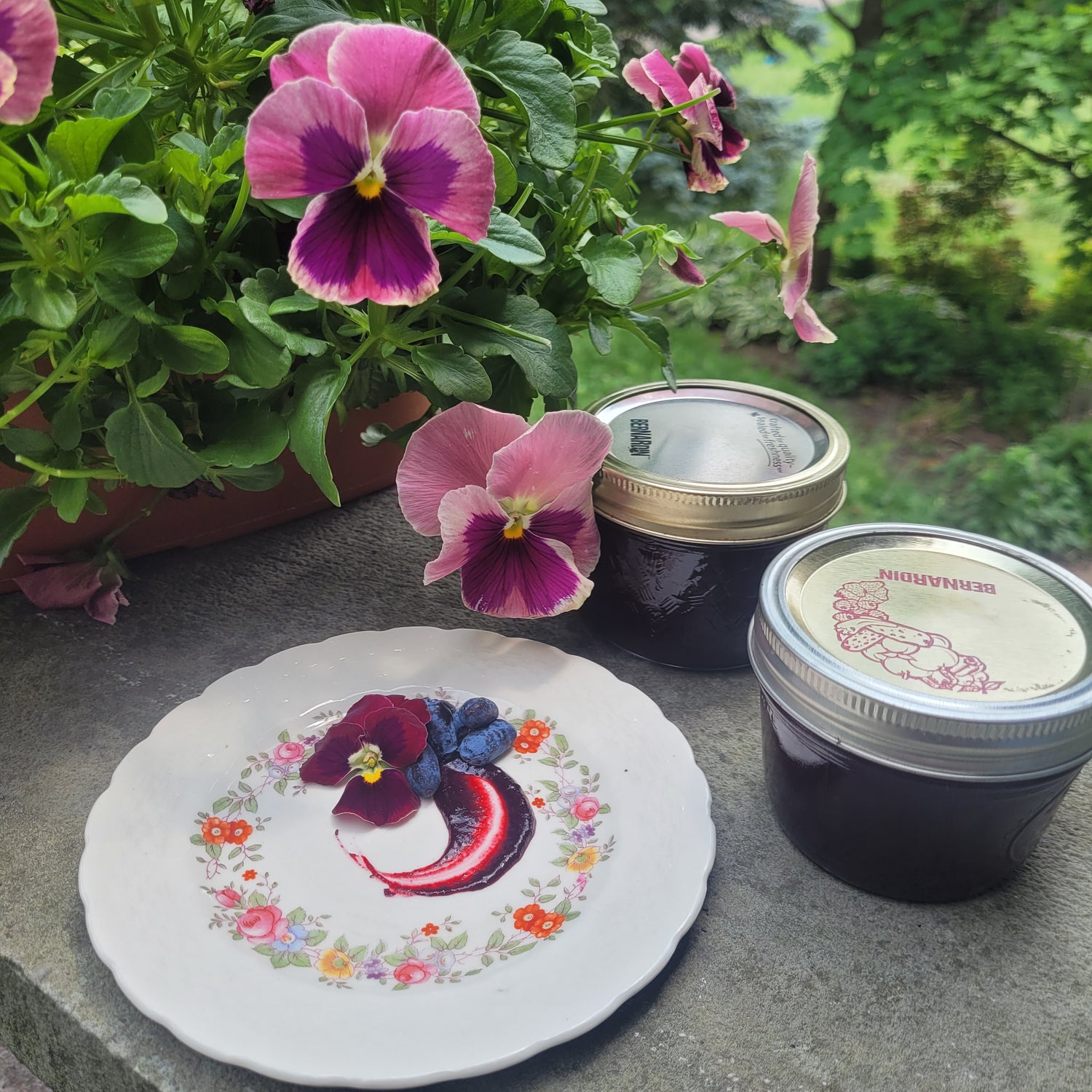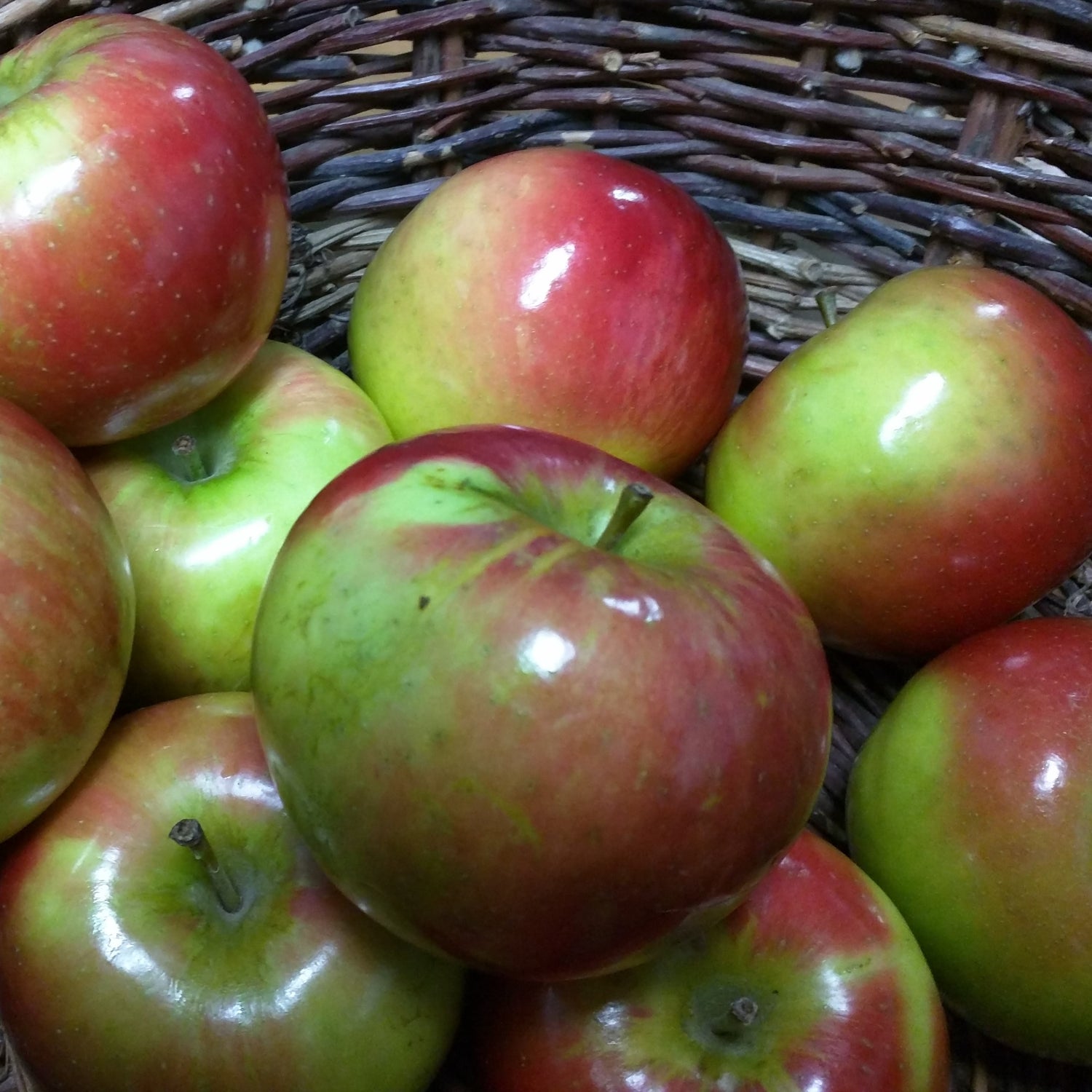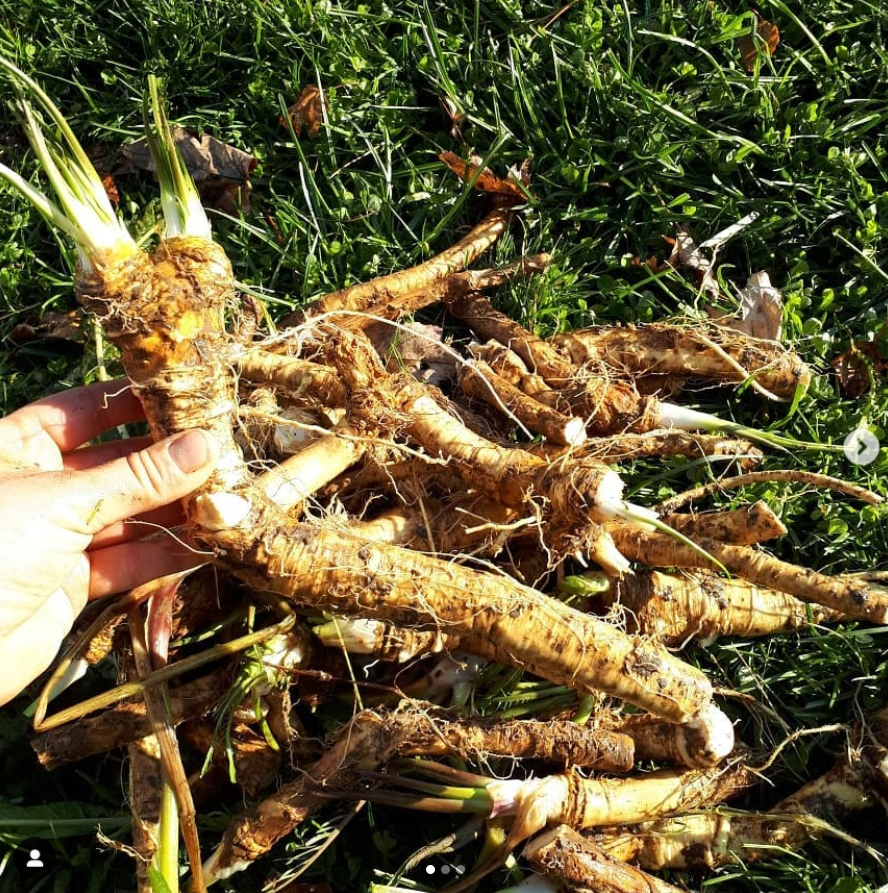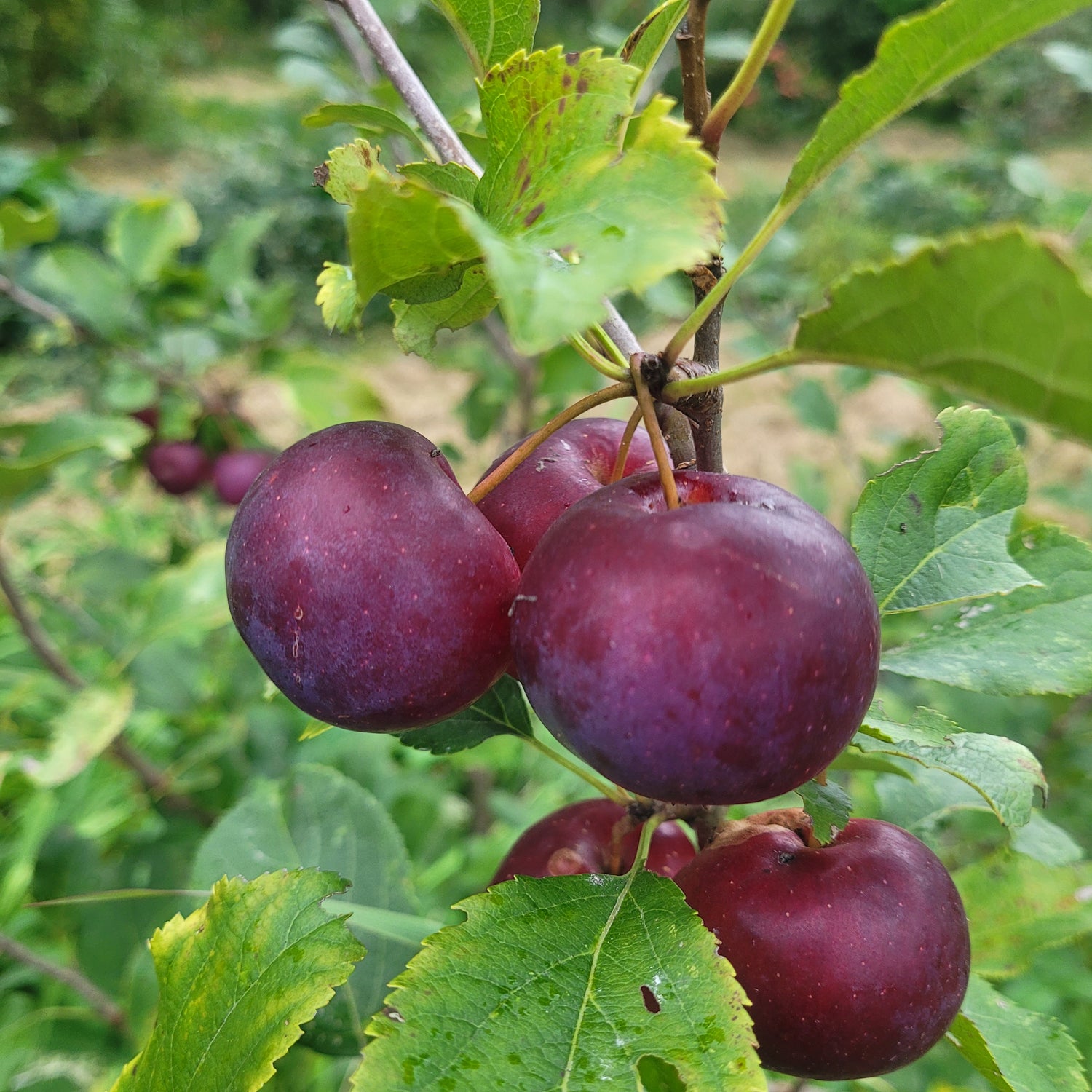Products
Sort by:
475 products
475 products
History: Granny Smith was discovered by Maria Ann "Granny" Smith as a chance seedling on her and her husband's farm in Australia in 1868. Having grown from apple seeds she had tossed, she found it to be an exceptional apple. She propagated it and brought the apples to market, earning the variety local popularity. She passed away two years later but local growers kept the variety going until it was noticed by the New South Wales Department of Agriculture in 1895. Thanks to its excellent shelf life, it became an important agricultural export and remains one of the most popular apple varieties in the world today. There has been an annual Granny Smith Festival in Eastwood since 1985 to commemorate Maria Ann Smith and her apple that attracts over 80k attendees each year.
Why We Grow It: This classic green apple barely needs an introduction! It is well known for its sweet and sharp flavour that is a delight for fresh eating and for its usage in cooking and baking. As an added bonus, Granny Smith also keeps well in storage and tends to start producing fruit at a young age.
History: Greengage plums are a European variety that originated in Iran, although it is unclear exactly how old they are. They were introduced to England via France in 1724 by Sir William Gage, after whom they were named in English when the French labels were supposedly lost in transit. These sweet plums were later brought to North American colonies where they were grown by prominent figures such as George Washington and Thomas Jefferson. Although they have since fallen out of favour in North America, they are still quite popular in western Europe and occasionally referenced in pop culture. Greengage plums are the namesake of The Greengage Summer, a 1958 novel and subsequent 1961 film, and are mentioned in a Monty Python sketch.
Why We Grow It: It is a shame this plum's popularity declined in North America since it is considered a high-quality dessert fruit, possibly even the best dessert plum. Their bright green flesh is incredibly sweet and can also be used for cooking and preserving. Greengage plum trees tend to have a compact growth habit, great for anyone without a lot of space.
History: Grimes Golden was discovered on the Grimes farm in what is now West Virginia in 1832. Local legend claims that it grew from a seed planted by John Chapman, better known as Johnny Appleseed. After its discovery, it was widely planted up until the 1930s when it became supplanted by more popular varieties such as its (likely) descendant, Golden Delicious.
Why We Grow It: Although less popular now than Golden Delicious, many claim that Grimes Golden has a superior flavour: sweeter and with a hint of spice. The fruit is great for fresh eating and making cider, and it stores quite well. The tree is moderately resistant to fire blight and mildew.
Are you thinking of growing fruit trees? Are you in a hurry to enjoy a delicious organic harvest? Fruit trees don’t grow overnight, but the choices you make and the care you give them can speed up the process. You don’t need a degree in horticulture, and you don’t need to use toxic sprays. Growing fruit trees successfully is simply a matter of knowing what to do and when to do it—and if you know what to look for, your trees will tell you exactly what they need.
This book is for you if you:
- Want to grow fruit trees (like apple, peach, pear, cherry, apricot and plum)
- Are looking for easy techniques that will give you abundant harvests
- Don’t have a lot of time to devote to fruit tree care
- Have never planted a thing
- Are an experienced gardener
- Want to avoid the frustration of trial-and-error learning
If your goal is to grow fruit trees fast, take an hour to read this book. Follow the simple steps inside and you’ll be enjoying a healthy harvest in record time.
Growing Figs in Cold Climates is a complete, full-color, illustrated guide to organic methods for growing delicious figs in cold climates, well outside the traditional hot, arid home of this ancient fruiting tree. Coverage includes:
- Five methods for growing figs in cold climates including overwintering
- Cultivar selection for cool and cold climates
- Pruning techniques for a variety of methods of growing figs in cold climates
- Pest problems and solutions
- Harvesting, including ways to speed ripening, identify ripe fruit, and manage an overabundance
- Small-scale commercial fig production in cold climates.
Fresh figs are juicy, full-bodied, and filled with a honey-sweet flavor, and because truly ripe figs are highly perishable, they are only available to those who grow their own.
By choosing the right cultivars and techniques, figs can be grown across cool and cold growing zones of North America, Europe, and beyond, putting them within reach of almost every gardener. Easy and delicious — if you can grow a houseplant, you can grow a fig.
Fruit trees are delicate and need specialized care, especially when they’re planted in an urban environment, which comes with its own unique challenges. Whether you want to plant a single fruit tree or an entire orchard, this book will show you how to save time and money and be successful right from the start.
Susan Poizner lives in Toronto, and is an excellent resource to anyone seeking to plant fruit trees in their back-yard. We find her book easy to read with clear, concise information and excellent pictures and diagrams.
Native Tree Discount: Purchase multiples of this tree & enjoy the savings!
We try to grow as many Native North American Trees as we can; enjoy our bulk quantity discount (see below) and add to cart to see how much you save!
Species: Celtis occidentalis
History: Hackberries can be found in parts of southern Canada and in the eastern and central United States. The berries produced by the tree are commonly eaten by winter birds and mammals like squirrels. Indigenous peoples traditionally eat the berries raw or use them in several dishes. Although they tolerate urban conditions well, they are relatively uncommon as street trees except in Sombor, Serbia, and Bratislava, Slovakia where they have been planted extensively.
Why We Grow It: These beautiful native trees resemble the American elm, but without the disease issues. Both birds and butterflies enjoy this tree. The sweet small fruit taste like dates with a large crunchy pit that can be eaten or discarded. Thanks to their unusually high levels of proteins, calories, and vitamins, they are a great food source. You can learn more about Hackberries as a food source via this blog post by Alan Bergo.
History: Haralson apples were developed at the University of Minnesota in 1922 and named after Charles Haralson who was superintendent of the university's fruit breeding farm. It is one of almost 30 apple varieties the university has developed in its breeding program since it began in 1888.
Why We Grow It: The skin of this variety is striped red with russet dots and the flesh is white, juicy, and of pleasant albeit mild flavour. Haralson boasts excellent cold hardiness and general disease resistance.
Species: Rubus sp
History: Hardy Black originated in Nova Scotia. As the name implies, the variety was selected for its hardiness along with excellent fruit.
Why We Grow It: This hardy variety produces large, dark berries that are sweet and juicy. To make it even better, they bear fruit over a long period of time which gives you that much more of an opportunity to enjoy these lovely berries.
History: Harlayne apricots were developed at the Harrow Research and Development Centre in Ontario and released in 1980. It is one of several specifically bred to survive in a southern Ontario climate and of the Harrow apricots it was the most cold hardy.
Why We Grow It: Harlayne is a cold hardy variety that can tolerate temperatures of -30°C. It is a medium-sized apricot and freestone. The skin is a bright orange with an attractive red blush and the flesh is sweet, making it great for fresh eating along with canning or preserving. Unlike most of our apricots, Harlayne requires a pollinator.
History: Harrison was first described in 1817 by William Coxe and became a very popular cider variety in New Jersey during the 1800s, making it one of few American varieties renowned for its cider properties. Harrison's popularity declined in the early 1900s and it was believed that this variety was lost to time until it was rediscovered in 1976 growing by an old cider mill in New Jersey. This rediscovery was just in time, as what may have been the last known Harrison trees were cut down only a week later. Following successful propagation, it is once again being grown by cider makers across North America. It is considered one of the best American apples both for fresh eating and cider.
Why We Grow It: Harrison produces a high quality cider and can be made into a single variety cider. Unlike most cider apples, Harrison can also be eaten fresh and has a pleasant if somewhat dry taste. It is also scab resistant and crops reliably each year.
History: Harrow Delight, as the name suggests, was introduced from the pear breeding program at the Harrow Research and Development Center in Ontario in 1981. It is a cross between Bartlett and Purdue 80-51, making it a sibling to Harrow Sweet.
Why We Grow It: Harrow Delight pears are green with red blush when mature. They have sweet, juicy flesh and keep about a month. The tree boasts resistance to both fireblight and scab, making it a good option for anyone looking for a more disease resistant pear variety.
History: Harry Masters Jersey was discovered in the early 1900s at Yarlington Mill (in England) and is thought to be a seedling of Yarlington Mill (the apple variety). It was named after Mr. Masters, a worker at the mill who is thought to have discovered the apple.
Why We Grow It: Although not the most vigorous of apple trees, the fruit itself boasts a medium-full bittersweet juice of vintage quality with low acid that makes it popular among cider connoisseurs. Harry Masters Jersey also starts producing fruit at a young age.
Species: Prunus persica
History: These seedlings are grown from Harson peach seeds collected from mother trees growing in Ontario. Harson was developed at the AAFC Harrow Research and Development Centre in Ontario and released in 1982.
Why We Grow It: Seedling fruit trees are a great way to add some diversity and mystery to your garden or orchard! We expect that seedling peaches will be even hardier trees than their parents! Harson produces a freestone peach that is great for fresh eating and canning. It is quite similar to Redhaven.
Please Note: Since peaches tend to stay true to type more than apples, these seedlings will likely bear a strong resemblance to their parent variety. However, any specific information listed on this page should be taken with a grain of salt as there may be some variation from the parent tree.
Species: Juglans ailantifolia var. cordiformis or hybrid. Our seeds are collected from trees that may have been cross-pollinated by closely related species so the resulting seedlings may be hybrids.
History: Heartnuts are a sport of the Japanese Walnut that have a heart-shaped shell and kernel instead of the usual elliptical shell. They have good commercial potential in the Great Lakes area where the climate is similar to that of Japan.
Why We Grow It: These trees produce an abundance of tasty nuts that are sweet than other walnuts and lack the bitter aftertaste. Ideally, they will produce heart-shaped nuts but since they are seedlings they may produce the usual rounder nuts of the regular Japanese walnut. They are sensitive to spring frosts for nut production, so they are best planted in a sheltered location.
History: Hedelfingen cherries were discovered in Germany around 1850. The variety was named for Hedelfingen, the area where it was found. They were introduced to England in 1907 and are still grown commonly in Europe and North America.
Why We Grow It: This is an excellent quality sweet cherry that is very popular in Ontario. The fruit is dark red in colour with faint speckles, softer flesh, a pleasant juiciness, and a great taste. The trees begin to bear at a young age, the fruit is resistant to cracking, and the blossoms are tolerant of frost.
A recommendation from one of our wonderful customers: Save the pits! Chef Sam advises infusing sweet cherry pits in whiskey for an alluring, aromatic, almond flavoured drink!
Species: Prunus avium
History: These seedlings are grown from Hedelfingen seeds from sweet cherries sourced in Ontario. First discovered in Germany in 1850, Hedelfingen has become a popular variety in Ontario.
Why We Grow It: Seedling fruit trees are a great way to add some diversity and mystery to your garden or orchard! The parent variety, Hedelfingen, is well-regarded due to its great flavour and later bloom time which makes it more tolerant of late spring frosts.
Please Note: Since sweet cherries tend to stay true to type more than apples, these seedlings will likely bear a strong resemblance to their parent variety. However, any specific information listed on this page should be taken with a grain of salt as there may be some variation from the parent tree.
History: Hendre Huffcap was first recorded in England either in 1923 or 1963. The confusion stems from whether it and another variety called Lumberskull, which was recorded first in 1923, are actually the same variety. Hendre Huffcap remains a popular perry pear in England.
Why We Grow It: This popular English perry pear has endured due to the high quality juice it produces which is great on its own and in blends. The tree bears heavily and reliably, although some thinning is recommended since the branches can break under the weight of its own crops.
Species: Rubus sp.
History: Heritage raspberries were developed by Cornell University in New York and introduced in 1969. It is one of the most widely grown raspberry varieties in the world due to the quality of its fruit and its extended bearing season. This variety is considered the standard for everbearing varieties and in 2004 it even received the Outstanding Fruit Cultivar Award from the American Society of Horticultural Sciences.
Why We Grow It: On top of the accolades mentioned above, these medium-sized red berries can also be harvested within the first year! You can enjoy them fresh or in baked goods, or freeze, dry, or preserve them to enjoy in the winter months. We find these to be sweeter than Nova, but with a milder flavour and slightly crumbly texture. The canes are thorny so exercise caution when working around this variety! You can cut down the canes in the winter for a large fall crop, or enjoy a more spread out crop from June to September. We have found cutting the patch down annually also helps with borer problems.
The second product photo shows Nova (right) compared to Heritage (left).
The third photo shows a Heritage and Nova raspberry tart Steph made!
History: Hewe's Virginia (aka Hughes' Virginia or Virginia) was discovered in Virginia in 1817 although the first trees discovered were thought to be around 100 years old. It is believed that Hewe's Virginia is a cross between a European apple and a North American crabapple. It became quite popular for its excellence as a cider apple and was favoured by Thomas Jefferson who devoted an entire block of his orchard at Monticello to just Hewe's Virginia. This variety was widely planted in the 18th and 19th centuries but waned as interest in cider-making declined. Luckily, it stuck around with us due to its usage as rootstock and pollinizers for other varieties. With the growing popularity of cider in the US, however, Hewe's Virginia is making a strong comeback as people are once again realizing its potential.
Why We Grow It: This hardy, vigorous tree produces a good number of crabapples that are excellent for cider. It is easy to see why this variety was so popular back in the day and is making a resurgence now, the bittersharp juice is great on its own and in blends. Hewe's Virginia is also great for making jelly!
Ever wondered about the mysterious 'Holistic Spray' we mention? Learn all about how we care for our trees without the use of harsh chemicals it in this workshop.
Join us bright and early to discuss spraying, the ingredients in a holistic spray, when, where, and most importantly, why we use this method! We will show you our set up and offer advice to make your own spray, for your own localized pest and disease pressures.
We are offering two different dates this year (select from below), for you to join for our 2026 Holistic Spray Workshop in order to accommodate a growing interest.
We are offering you a choice of either Friday, April 10th, 2026 (5:30pm-7:30pm) OR Saturday, April 11th, 2026 (9am-11am).
Registration includes a 2 hour mini-workshop, where you’ll learn:
-the theory behind this method/what is a holistic spray
-how to make a holistic spray
-what ingredients you’ll need
-how to tweak it to suit your needs based on your localized pest pressures
-when to spray (seasonally + time of day)
What to Bring: a lawn chair and note taking material. We will pass around a handout with the basic recipe. Michael Phillip’s book will also be available for purchase; it is an
invaluable resource!
Please also dress for the weather: we will be outdoors or in an unheated hoop house depending on the weather, followed by a quick tour of the orchard when when we do a demo spray.
History: Holstein was discovered in Schleswig-Holstein, Germany in 1918 and became one of the most popular varieties in the country. It is possibly a seedling of Cox's Orange Pippin.
Why We Grow It: This popular German variety sports attractive yellow skin with an orange/red blush. The flesh is firm, juicy, and aromatic in a way that is reminiscent of Cox's Orange Pippin. In general, this variety is easy to care for and grows vigorously.
Species: Lonicera caerulea
History: Little is known about the origins of Honey Gin aside from the fact it originated in Russia.
Why We Grow It: This variety boasts a unique sweet flavour with hints of smoked plum. Honey Gin's berries are 2cm long and deep blue and juicy. They can be used in a wide variety of ways such as fresh eating or cooking but are generally noted for their excellence in wine, gin, and vodka production.
Species: Gleditsia triacanthos
History: Honey Locust is native to the central United States where it has been used by indigenous peoples as a source of food and medicine. Its name is derived from the pulp inside the pea pods which is quite sweet and crisp. It has been commonly planted as a landscape tree in many places around the world due to its ability to survive many conditions too harsh for other trees. Unfortunately, Honey Locust's tenacious nature has caused it to become invasive in some places.
Why We Grow It: Reaching 30 meters tall, this native nitrogen fixing tree benefits many including bees, wildlife, and even humans: we can use the sweet (honey flavoured) pulp inside their pods in baking, tea or for brewing beer. Honey Locusts grow impressive thorns, 3-10 cm long which can be used for pins or nails in a pinch and the durable, rot-resistant wood has a variety of uses.
History: Honeycrisp apples were developed by the University of Minnesota in the 1960s and released in 1991. It is one of almost thirty varieties created by the university's breeding program since it began in 1888. The excellent flavour of Honeycrisp has allowed it to become one of the most popular apples in North America and in 2006 it became the state fruit of Minnesota.
Why We Grow It: Honeycrisp is popular for a reason. The apples are large and attractive with good flavour under favourable growing conditions. However, they are not an apple for beginner growers due to issues with some diseases especially in storage, but with diligent care you can produce these crunchy sweet apples in your own backyard/orchard.
History: Honeygold apples were developed by the University of Minnesota and introduced in 1970. It is one of nearly 30 varieties that have been developed by the university's breeding program since it began in 1888. This apple is a cross between Golden Delicious and Haralson, designed to combine the taste of the former with the cold hardiness of the latter. Honeygold is also famous for being mistakenly identified as one of the parents of Honeycrisp, although that has since been rectified.
Why We Grow It: With the sweet taste and appealing look of Golden Delicious but the cold hardiness of Haralson, this is an excellent apple for anyone living in colder hardiness zones. It is great for fresh eating as well as making pies and applesauce. The tree is also somewhat scab resistant.
Species: Armoracia rusticana
History: Horseradish originated somewhere in the Mediterranean and has been well known since ancient history, appearing in writings from Ancient Greece, Ancient Rome, and the Renaissance. It has historically been used for both culinary and medicinal purposes in Europe and was introduced to North America by European colonizers where indigenous peoples also adopted it for medicinal use. Today, horseradish is commonly grown around the world and used in cooking or to make sauces. An enzyme in horseradish also has applications in molecular biology and biochemistry!
Why We Grow it: Horseradish is a root vegetable with a distinctly pungent and sharp taste. As a result, it is most often used in cooking and making sauces/condiments. It is a hardy vegetable and has a tendency to spread through the garden so extra care should be taken to keep it contained when planting it.
Life Design for Resilient Living
As climate change, ecological decline, and social breakdown start to bite, people expect that governments will solve our problems. Yet this belief has proven to be false. Rather than looking to others, changes must come from the inside out: transforming the "I" to "we," changing the world by changing ourselves, and re-establishing our deep connection to nature.
Human Permaculture is a powerful, forward-thinking guide that uses permaculture principles of ecological design rooted in people care, Earth care, and fair share for redesigning your life and community to align with the resources available on the planet.
Richly illustrated and inspiring, Human Permaculture offers specific actions and tools for adopting an ethical, regenerative way of life. Coverage includes:
- Human permaculture principles
- A nine-step ecological and social life design process
- Discovering your personal niche
- Stimulating the permaculture "edge effect" to work with others in efficient teams
- Rediscovering our deep connections to water, soil, forests, and caring for nature.
This guide is for everyone who wants to find their own meaning in life, put their talents at the service of the environment, live ethically, and navigate the great transition we face in a future of climate change and energy decline.
Bernard Alonso is co-founder of the Collaborative International University of Transition and a human permaculture facilitator, speaker, coach, and project designer. He lives in Quebec, Canada. www.permacultureinternationale.org
Cécile Guiochon is a French journalist and holder of a Permaculture Design Certificate. She co-founded KerWatt, which develops citizen projects renewable energy in Brittany, France. www.e-ker.org
History: The exact origins of Hyslop are unclear but it was discovered sometime in the early 1800s around Boston by the Hyslop family who helped develop the area. This apple was popular for over a century but in recent years has fallen into obscurity.
Why We Grow It: Although definitely not recommended for fresh eating, Hyslop crabapples have a sub-acid, astringent flavour and are great in cider blends. They are also known as being one of the best apples for jellies. The tree is quite attractive with blue tinged blossoms in the spring and brilliant red/purple fruit in the fall.


